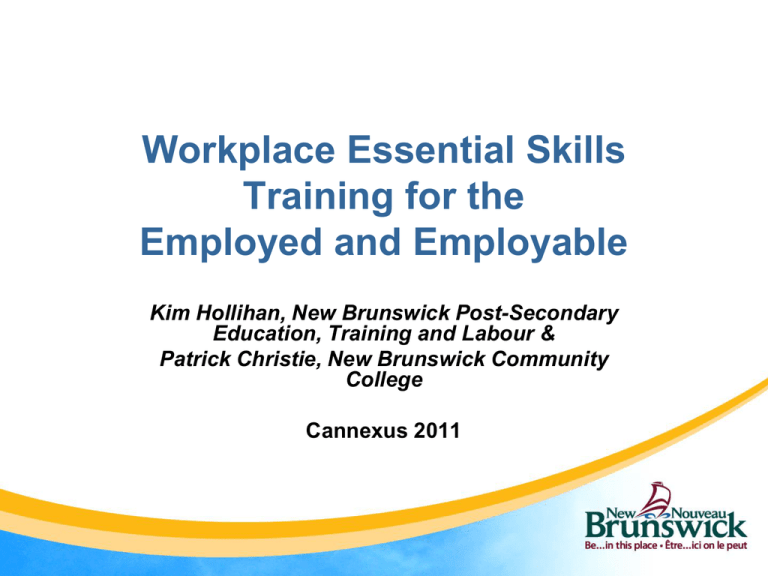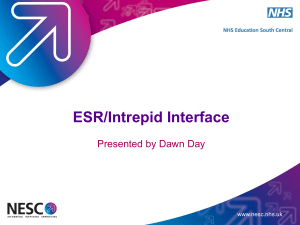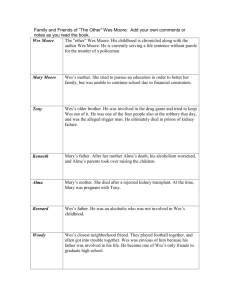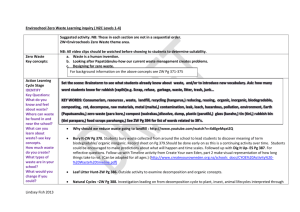Workplace Essential Skills
advertisement

Workplace Essential Skills Training for the Employed and Employable Kim Hollihan, New Brunswick Post-Secondary Education, Training and Labour & Patrick Christie, New Brunswick Community College Cannexus 2011 Presentation Outline Program Mandate and Objectives Overview of WES Program HRSDC Essential Skills Model WES Delivery Process Demonstration of NBWES Resources Status Update Benefits for Learners and Employers Questions Source: IALSS 2003 Why WES in NB? Population Distribution of Prose Proficiency 100% 19.50% 38.60% 14.40% 35.30% 50% 27.30% 33.80% 14.60% 16.60% Canada New Brunswick levels 4/5 level 3 level 2 level 1 0% Population 16-65, Canada and New Brunswick, 2003 Program Mandate and Objectives Mandate : To increase literacy through essential skills training. Objectives : • Improve adult literacy • Provide an accelerated path to skills improvement • Increase participation in the labour force to ease labour market needs • Promote the development of a workplace culture that reinforces that learning at all life stages is the key to full and equal participation in our economy and society • Explore certification and recognition WES Training Utilizes… • A Departmental team approach WES Training Utilizes… • NB WES curriculum covering all 9 Essential Skills WES Training Utilizes… • Authentic workplace materials WES Training Utilizes… • Competency-based approach WES Training Utilizes… • Assessment of prior learning WES Training Utilizes… • Formalized assessments for learners and workplace Infrastructure (all within PETL) • PETL Leadership Team – decision makers • WES Central Office Team – provincial organizers • WES Regional Teams – 7 delivery teams • WES Centres of Excellence – expertise/resources in essential skills (Bathurst/Saint John) – provincial in scope (French/English) • PETL Regional Coordination Groups – 7 to ensure seamless delivery in regions The HRSDC Essential Skills (ES) Model “ Essential Skills help people perform the tasks required by their occupation, provide people with a foundation for learning other skills, and enhance people’s ability to innovate and adapt to workplace change.” http://www.hrsdc.gc.ca/eng/workplaceskills/ The HRSDC ES Model, cont. Reading Text Document Use Numeracy Writing Oral Communication Working with Others Thinking Skills Computer Use Continuous Learning www.hrsdc.gc.ca/eng/worplaceskills/essential_skills/general/ understanding_es.shtml The HRSDC ES Model, cont. Includes ES Profiles that correspond to the job descriptions in the National Occupational Classification (NOC). • A brief description of the occupation • A list of the most important Essential Skills • Example tasks that illustrate how each Essential Skill is applied • Complexity ratings that indicate the level of difficulty of the example tasks • The physical aspects of performing the job and the attitudes that workers feel are needed to do the job well • Future trends affecting Essential Skills Two Main Delivery Streams Employed delivery stream takes place in the workplace/HUB and answers employer needs Employable stream takes place in a community setting and answers learner and sector needs by matching potential employees with employers, and/or provides learners with essential skills to prepare them for today’s workforce WES / CET WES/CET Employable Labour exchange Referred / self-referred Employed Workplace / Sector / Hub WES Delivery Process 1. Initial contact 2. Diagnostic of employer/sector/industry/community needs 3. Formation of a Project Team 4. Completion of the Training Needs Assessment 5. Recommendation and development of a training plan 6. Implementation of training in the workplace or community 7. Monitoring of learner progress and evaluation of initiative outcomes TRAINING NEEDS ASSESSMENT Initial contact Gap Analysis and Training Recommendation Learner Assessment WES Data Gathering ES Profile Demonstration of NBWES Resources Provincial Database of WES Training/Learning Materials Examples of NBWES Initiatives Examples of NBWES Initiatives PETL Contribution Assessment of organizational and individual needs Provision of occupational profile Recommendation of programs 100% of Trainer’s salary WES curriculum Instructional materials Participation on the Project Team Workplace/Sector/Industry Contribution Provide a classroom suitable for adult learning Time allowed for an employee to be a member of the Project Team Time for staff to participate in the assessment of organizational and individual needs Time for staff to attend training Participation in the program evaluation Other contributions identified and/or negotiated by the Project Team Benefits for Learners Participation in WES training could result in learners: • increasing their employability by enhancing their essential skills • believing they have more capabilities and having more selfconfidence • taking greater pride in their work • accepting and acting upon suggestions for their own improvement • developing a positive attitude toward continuous learning • showing more initiative and becoming more innovative • working and making decisions more independently • getting better at detecting and solving problems • working more effectively in teams • having an improved ability to cope with change… Benefits for Employers • Both employers and employees are concerned about the ability of today’s workforce to take on new and more complicated assignments. Poor literacy and essential skills levels are barriers to making the changes and improvements needed to compete in today’s world. Source: Business Results Through Literacy Guidebook, Canadian Manufacturers & Exporters – Ontario Division and HRSDC, 2004 Benefits for Employers, cont. • Improving the literacy and essential skills levels of employees will : – improve productivity, quality and safety – improve flexibility – improve employee relations Source: Business Results Through Literacy Guidebook, Canadian Manufacturers & Exporters – Ontario Division and HRSDC, 2004 The Learners’ Perspective… “I’ve learned to communicate better and to assess situations more clearly.” “Today, I’m more professional working with employees, and the outcome is that both parties are much more satisfied and happy.” “I applied information from this course to work with my team and my family, for example the kids.” “I never thought I could go back to school” The Employer’s Perspective… “…we believe that everybody can learn and grow through education. I also know not all lessons can be taught; some have to be lived. Workplace learning in organizations can provide these opportunities and enable anybody.” (Employer) “At first, I could sense that the learners didn’t want to participate. These guys had jobs to do, and training was pretty low on their priority list. After a year, they have started to experience the benefits of training and now ask for more.” (Workplace Trainer) Questions/Comments? Thank you! Kim.Hollihan@gnb.ca Patrick.Christie@gnb.ca











